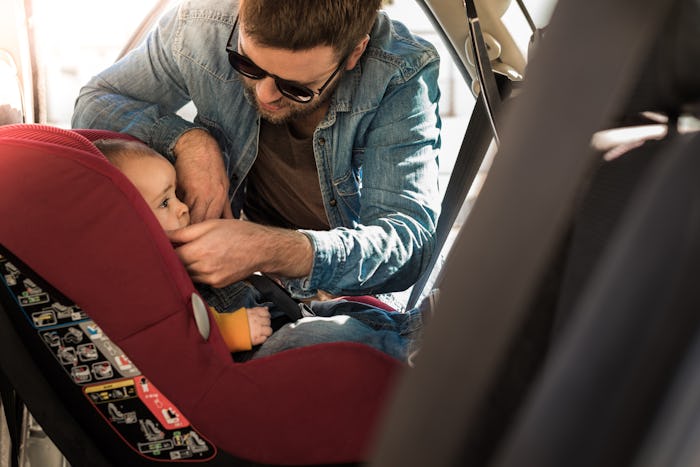A car seat is a must-have piece of baby gear — you won't be able to leave the hospital with your baby unless you have one. In fact, you will likely have to invest in a few different models as your baby grows. But just how long will you have to keep your baby strapped in before you can ditch the car seat for good? How long your kid will need to be in a car seat depends on a few things. That being said, it's probably a lot longer than you thought.
In the beginning, you'll tote your tot around in a rear-facing car seat. The American Academy of Pediatrics recommended infants and toddlers ride in a rear-facing car seat until age 2, or until they reach the maximum height and weight recommended by their car seat manufacturer. According to The Car Seat Lady, many convertible car seats on the market can accommodate rear-facing children up to 50 pounds.
Additionally, Baby Center noted that very young children are at greater risk for head and spinal cord injuries during a crash because their bones are still developing. A rear-facing car seat does a better job of protecting them from the impact of a crash. And though you may think the rear-facing position is causing your baby to be squished as her legs grow, it really is the safest choice. If your baby rides in a rear-facing seat, the chance that she will suffer injuries to her arms and legs during a crash is less than 1 in 10,000, as Baby Center added.
Once your little one is ready to face forward, he will likely transition to a forward-facing car seat with a harness. According to the American Academy of Pediatrics, these seats typically accommodate children who weigh between 40 and 80 pounds. The AAP advised, however, to keep your kid in a seat with a harness up to at least age 4. Along with the weight requirement, your child's height will also help you determine when it's time to move on. As The Car Seat Lady advised, your child's ears should not be taller than the top of the seat.
When your child has reached the maximum height and weight for the forward-facing seat, they will graduate to a belt-positioning booster seat. As AAA mentioned, children should use the booster until they are at least 4'9" and between 8 and 12 years old, when the adult safety belt should fit properly without the seat. But you should also consider whether or not your child is ready to sit still when they have more freedom of movement.
"I think the child's maturity level also needs to be considered when transitioning to the booster seat," Sarah Tilton, Director of Consumer Advocacy for BRITAX Child Safety, Inc. tells Romper. "Once in the booster, they have the same freedom [of movement] we have in a seat belt," she adds.
It may be tough to keep your kid strapped in, especially when many of their friends have long kissed their car seat goodbye. But as AAA mentioned, each time you move on to the next phase, you are taking away a level of protection for your child. So let safety rather than peer pressure guide your decision.
